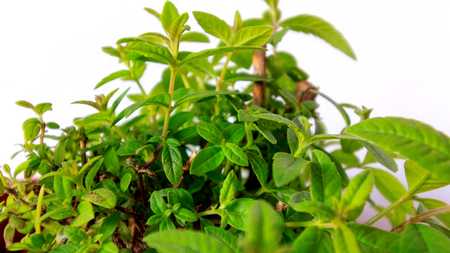The article shows how to plant and grow Lemon Verbena (Aloysia citrodora, Lemon Beebrush) at home and how to take care of it. Lemon Verbena, native to western South America, is a perennial fragrant herb that adds a citrusy fragrance to the garden due to its lemon-scented leaves. Its leaves and flowers are edible and used in drinks, foods and medicine, but the plant is toxic to dogs, cats and horses when eaten, causing colic and stomach ache to them.
 |
| Lemon Verbena Tree |
The lemon verbena is a perennial shrub growing to 2-3 m high. It is a low maintenance plant that grows as a perennial in warmer climates, USDA Zones 8 to 11 or as an annual in colder climates.
Lemon Verbena Propagation
You can grow lemon verbena from seeds or cuttings. The lemon verbena seeds have a low germination rate. If starting from seeds, sow them indoors a few weeks before the last expected frost.
The cuttings can root in soil or water. Place the cuttings in a glass of water, they will root in a few weeks. Once the lemon verbena cuttings take roots in water, you can plant them in soil.
Location: Where to Plant
Lemon verbena thrives in warm climates, but it can be grown in a variety of conditions. Select a location that receives full sun to partial shade, providing at least 6 hours of sunlight daily. Ensure that the soil is well-draining to prevent waterlogging, as lemon verbena prefers slightly dry conditions.
The lemon verbena outdoor plant drops its leaves and go dormant when the temperature falls below 4.44°C (40°F). The plant will die below 0°C (32°F), so move it indoors.
Can Verbena Grow Indoors
Lemon Verbena plant is not easy to grow indoors, but can be grown if you can provide the plant the needed very high sunlight and temperature levels. That may be challenging to meet these requirements for long. Because lemon verbena is sensitive to frost, But it would be best to grow it in a container indoors in winter and during frost.
Soil Preparation
Lemon verbena prefers a well-draining, slightly acidic to neutral soil *(pH 6.0-7.5). Enhance the soil with organic matter, such as compost or manure to improve its fertility. Loose soil essential, otherwise, the plant will die if roots stay constantly wet.
Planting
The easiest way to grow lemon verbena is with a small plant from a nursery. Carefully take out the plant and plant it in well-draining soil at the same depth as it was in its nursery pot.
Watering
Lemon verbena prefers slightly dry soil between waterings, so be careful not to overwater. Water deeply but infrequently. Ensure that the soil is consistently moist during the first growing season to help establish the plant's root system.
Fertilizer
The lemon verbena is a heavy feeder, give all-purpose fertilizer in the spring. Avoid excessive use of fertilizer high in nitrogen, as that can lead to foliage growth at the expense of the aromatic oils in the leaves.
Pruning
Regular pruning not only helps maintain the plant's shape but also encourages bushier growth and enhances air circulation. Prune your lemon verbena in the spring to remove dead or leggy branches. This will stimulate new growth and keep the plant compact.
Pest and Disease Control
Lemon verbena is resistant to pests and diseases. However, aphids, spider mites and whiteflies may be the problem. You can spray neem oil to control the insects and bugs.
Standing water in soil or water retaining soil can lead to root rot, which many kill the plant.
If growing indoors during winter, low light and less humidity make it susceptible to insects.
Lemon Verbena Flowers
The plant produces sprays of tiny lilac or white flowers in late Spring to Summer. The flowers of Lemon Verbena are considered as symbols of holy, sacred and healing. Romans and Greeks used the plants to help purify important places such as temples and altars.
Harvesting Lemon Verbena
Lemon Verbena leaves are most flavorful when the plant has flowered. Snip off the leaves or trim entire stems as needed. The best time to harvest is in the morning when the aromatic oils are most concentrated.
 |
| Lemon verbena leaves and flowers |
Harvest for Cooking: Its leaves smell and taste like lemon and can be used in place of fresh lemon or lemon zest. You can harvest and use the leaves fresh or dried for culinary purposes throughout the growing season. Add them to teas, salads, desserts and beverages.
Harvest for Scent: Cut stems of lemon verbena and put them in flower vase in water to spread lemon scent in room. Continue to cut flowers throughout the growing season and make scented bouquet for indoors.
Medicinal Uses: Lemon verbena is known for its medicinal benefits such as for digestion and reducing stress.
Storage
You can preserve and store lemon verbena leaves for later use. Cut the stems and hang them upside down in the dark to dry the leaves in air. Then store the dry leaves in air tight containers.
Growing Lemon Verbena in a Pot
Lemon verbena is a good plant to grow in a pot. You can grow it easily in a pot having drainage holes. The plant may grow to a height of about 2-3 feet, depending on the size of the container.
Plant in well-draining potting soil mix as mentioned above.
Lemon verbena can die in frost and winter, so bring the pot indoors and place it where it receives as much sunlight as possible. Cover the plant with a thick layer of mulch to protect it from freezing temperatures.
Pruning: If the plant has grown too big, trim the plant by one third to keep its size manageable. Prune by trimming the growing tips of the branches in spring. This encourages new growth and the plant becomes bushy.